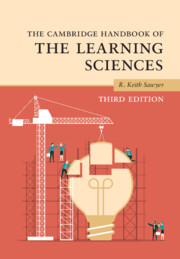Book contents
- The Cambridge Handbook of the Learning Sciences
- The Cambridge Handbook of the Learning Sciences
- Copyright page
- Contents
- Figures
- Tables
- Contributors
- Preface
- 1 An Introduction to the Learning Sciences
- Part I Foundations
- Part II Methodologies
- Part III Grounding Technology in the Learning Sciences
- Part IV Learning Together
- 19 Knowledge Building and Knowledge Creation
- 20 Computer-Supported Collaborative Learning
- 21 Arguing to Learn
- 22 Informal Learning in Museums
- Part V Learning Disciplinary Knowledge
- Part VI Moving Learning Sciences Research into the Classroom
- Index
- References
22 - Informal Learning in Museums
from Part IV - Learning Together
Published online by Cambridge University Press: 14 March 2022
- The Cambridge Handbook of the Learning Sciences
- The Cambridge Handbook of the Learning Sciences
- Copyright page
- Contents
- Figures
- Tables
- Contributors
- Preface
- 1 An Introduction to the Learning Sciences
- Part I Foundations
- Part II Methodologies
- Part III Grounding Technology in the Learning Sciences
- Part IV Learning Together
- 19 Knowledge Building and Knowledge Creation
- 20 Computer-Supported Collaborative Learning
- 21 Arguing to Learn
- 22 Informal Learning in Museums
- Part V Learning Disciplinary Knowledge
- Part VI Moving Learning Sciences Research into the Classroom
- Index
- References
Summary
This chapter reviews research on learning in science centers, art museums, children’s museums, zoos, aquariums, botanical gardens, and natural and cultural history museums. These are sometimes referred to as free choice learning environments because visitors are guided by their own interests, not by a predetermined curriculum. Museum learning is public and social, whether in peer groups or with families. Museums expand our definition of learning; they require learning scientists to account for forms of knowledge, behaviors, and interactions that are often different from those in school. This chapter identifies the key features of museums as unique learning environments; it reviews research on family learning in museums; and it reviews how museums are extending their educational mission by working together with schools, community organizations and networks, and citizen science initiatives.
Keywords
- Type
- Chapter
- Information
- The Cambridge Handbook of the Learning Sciences , pp. 448 - 464Publisher: Cambridge University PressPrint publication year: 2022



